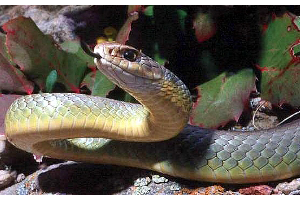When confronted by a person, racers, like many snakes, sometimes vibrate their tails. In dry vegetation, this may produce a sound similar to that made by rattlesnakes, which are very poisonous.
Photo Credit: Geoffrey A. Hammerson
Coluber constrictor
Common Name: racer
Other Common Names: North American racer
Animal Guild: Reptile
Class > Order > Family: Reptilia > Squamata > Colubridae
What does the species look like?
The upper surface of adult racers varies from black (in the northeastern U.S.) to plain brown or olive (in most of the western and central U.S.), with a spattering of white, yellowish, buff (light brownish-yellow), or pale blue (in parts of the south-central U.S.). Their upper scales are smooth (unkeeled), and their belly is black (in the northeastern U.S.) to plain yellow or cream (in the western and central U.S.). Their eyes are large, and their nostrils are bordered by two separate scales. Their anal scale is divided, and they usually have 15 scale rows at their anal opening. They can reach a total length of up to around 74.8 inches (190 cm) in the northeastern United States, but are much smaller (usually less than 35.4 inches or 90 cm) in the west.
Hatchling: Their upper surface has numerous brown blotches on a paler background. Their eyes are relatively huge.
Where is the species found?
States & Provinces
AB, AL, AR, AZ, BC, CA, CO, CT, DC, DE, FL, GA, IA, ID, IL, IN, KS, KY, LA, MA, MD, ME, MI, MN, MO, MS, MT, NC, ND, NE, NH, NJ, NM, NV, NY, OH, OK, ON, OR, PA, RI, SC, SD, SK, TN, TX, UT, VA, VT, WA, WI, WV, WY
Distribution
The range extends from southern British Columbia, southern Saskatchewan, Wisconsin, Michigan, southern Ontario, New York, and southern Maine southward in the United States to southern California, Arizona, New Mexico, Texas, the Gulf Coast, and southern Florida, and southward through northeastern, central, and southern Mexico to Guatemala and Belize. Elevational range extends from sea level to about 8,300 feet (2,550 m).
This species lives in a wide range of lowland and montane areas, including deserts, prairies, sandhills, shrublands, woodlands, forests, canyons, streamsides, and agricultural areas. Racers are absent from the driest deserts and highest mountains (subalpine zones and higher). They commonly climb shrubs and small trees. When inactive, they hide underground in crevices or under surface cover.
General Phenology and Life History
Racers are inactive during cold weather and are dormant from October or November to March or April in much of their range. They are active on bright overcast or sunny days in summer, but typically only on sunny, relatively warm days in spring and fall. They mate on the ground or above ground on plants in spring. They lay eggs in June or early to mid-July in most areas. They usually lay eggs in underground tunnels or burrows, rotting stumps, sawdust piles, or under rocks. Eggs hatch about 6 to 9 weeks after they are laid, generally in August or early September.
Which phenophases should I observe?
Do you see/hear...?
Activity
Individuals on land More...
For abundance, enter the number of individual animals observed in this phenophase.
Feeding For abundance, enter the number of individual animals observed in this phenophase.
Development
Young individuals For abundance, enter the number of individual animals observed in this phenophase.
Dead individuals For abundance, enter the number of individual animals observed in this phenophase.
What do these phenophases look like?
There is currently no photoguide available for this species. If you'd like help us create one, use the guidance document and species template provided here . Then send it via email to education@usanpn.org when it is complete.
